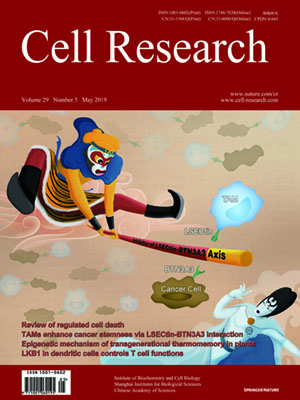
Volume 29, No 5, May 2019
ISSN: 1001-0602
EISSN: 1748-7838 2018
impact factor 17.848*
(Clarivate Analytics, 2019)
Volume 29 Issue 5, May 2019: 420-422
LETTERS TO THE EDITOR
Neuroendocrine prostate carcinoma cells originate from the p63-expressing basal cells but not the pre-existing adenocarcinoma cells in mice
Dong-Kee Lee 1, Yonghong Liu 1,2, Lan Liao 1, Wenliang Li 3, David Danielpour 4 and Jianming Xu 1
1Department of Molecular and Cellular Biology, and Dan L. Duncan Comprehensive Cancer Center, Baylor College of Medicine, One Baylor Plaza, Houston, TX 77030, USA; 2Institute of Biosciences and Technology, Texas A&M University Health Science Center, Houston, TX 77030, USA; 3Texas Therapeutics Institute, Brown Foundation Institute of Molecular Medicine, University of Texas Health Science Center at Houston, Houston, TX 77030, USA and 4Division of General Medical Sciences-Oncology, and Department of Pharmacology, Case Western Reserve University School of Medicine, Cleveland, OH 44106,USA
Correspondence: Jianming Xu (jxu@bcm.edu)
Dear Editor,
The prostate epithelium consists of p63/cytokeratin 14/cytokeratin 5-expressing (p63+/K14+/K5+) basal cells (BCs), K8+/androgen receptor (AR)+ luminal epithelial cells (LECs), and neuroendocrine cells (NECs) expressing synaptophysin (Syp), neural cell adhesion molecule (NCAM) and neuron-specific enolase (NSE). We previously demonstrated that BCs could differentiate into all three cell lineages in the prostate of postnatal mouse.1 The LEC-originated AR+ prostate adenocarcinomas are treated with anti-androgen/AR endocrine therapy. However, the AR-negative (AR–) neuroendocrine prostate carcinoma (NEPC) is usually associated with castration resistance, metastasis, resistance to chemotherapy, and poor prognosis. Approximately 2% of all prostate cancers (PCa) are NEPCs, and ~30% of adenocarcinomas contain focal NEPC cells after androgen deprivation therapy.2,3 Previous studies suggested that NEPC might originate from NECs,4 cancer stem cells (CSCs),5 or pre-existing adenocarcinoma cells via transdifferentiation.2,6,7,8 However, no lineage tracing study has been performed to test whether NEPC can arise from BCs without transdifferentiation.
https://doi.org/10.1038/s41422-019-0149-4
FULL TEXT | PDF
Browse 1304


